Police In DC Arrest Man Outside Church With Alleged Explosives
Washington, D.C., stood on an uneasy edge of catastrophe last Sunday when police arrested Louis Geri, 41, outside the Cathedral of St. Matthew the Apostle with what authorities describe as a cache of more than 200 homemade explosive devices and a manifesto that singled out the Supreme Court and religious communities.
The arrest, timed to the cathedral’s annual Red Mass on October 5 — a ceremony historically attended by justices and meant to pray for the high court as it begins a new term — read like the prevention of a narrowly averted catastrophe: no justices attended this year, and their absence, authorities say, was justified.
Geri was found occupying a green tent on the church steps when officers moved to clear the area for the event. According to the affidavit, he openly warned police to call “the federales,” claiming he had explosives, and threatened to demonstrate by throwing a bomb into the street: “I have a hundred plus of them.”
When officers insisted he move, he escalated, warning of deaths and handing over nine pages of a written manifesto titled “Written Negotiations for the Avoidance of Destruction of Property via Detonation of Explosives.” The document, officials say, expressed animosity toward the Catholic Church, members of the Jewish faith, Supreme Court justices, and ICE — a list that framed the act as ideologically motivated.
The arrest sequence was tense and cinematic: Geri thumbed a lighter as if to ignite it, urinated on a tree, and, when restrained, reportedly produced a vial in his pocket that a bomb technician described as containing combustible liquids and an attached “M-device.” A subsequent sweep of the tent uncovered what police have called a “large cache of handmade destructive devices.”
Lab analysis reportedly identified nitromethane among the liquids and strong acetone odors — indicators, police contend, of potentially functional explosive mixtures. Geri is now jailed without bond and faces a slate of charges including possession of destructive devices and a weapons-of-mass-destruction count labeled a hate crime.
The incident lands in a fraught moment. Officials say the attempted targeting of a ceremony linked to the Supreme Court heightens concerns about threats to the judiciary and religious communities.
The courtroom and political responses that will follow — criminal prosecution, security reviews for public events, and perhaps broader debates about judicial safety — will shape how authorities and institutions react to threats that blend ideological grievance with accessible, improvised weaponry.
For now, the immediate danger has been contained, but the arrest raises urgent questions about motive, radicalization pathways, and how public gatherings tied to high-profile institutions can be protected in an era of escalating political violence.


